Mazda BT-50 arrives
Home >
News >
Mazda
Other stories:
GM's
new Colorado ute production begins
23rd October, 2011
Ford
Ranger arrives
23rd October, 2011
Updated
Toyota HiLux released
9th September, 2011
Mitsubishi's
3-tonne towing capacity
8th November, 2010
Nissan
Navara & Pathfinder to get more power
17th October, 2010
23rd October, 2011
The all-new Mazda BT-50 is a utility with SUV-like power
and handling to go wherever work, the family or hobbies demand.
This all-new Mazda BT-50 is intended to give performance that realises an enjoyable,
confidence-inspiring, environment-friendly, and economical driving experience not previously offered by
Mazda utes. The overall driving dynamics are better, with improvements in performance, steering and
handling, ride quality, braking performance, and quietness.
To give an improved performance feel through responsive engine performance while achieving good fuel
efficiency and low emissions, the all-new Mazda BT-50 has an entirely renewed, potent powertrain
line-up consisting of 2.2 litre and 3.2 litre diesels along with 6-speed manual and 6-speed automatic
transmissions.
Light, compact engines and highly efficient transmissions work together to reduce fuel consumption
and carbon-dioxide (CO2) emissions for greater environmental performance. They also suppress noise
and vibration for a more comfortable, quieter ride.
Engines
There are two newly developed common-rail, direct-injection, turbocharged diesel engines (the MZ-CD
3.2 I5 and MZ-CD 2.2 I4) which are tuned to match the BT-50's reliable pickup characteristics. These
new diesel engines replace the MZR-CD 3.0 and MZR-CD 2.5 on the outgoing model. The new engines
offer power and torque increases with improved fuel efficiency and lower CO2 emissions.
MZ-CD 2.2
The new 2.2 litre common-rail direct-injection diesel engine has the same basic structure and fuel
supply system as the MZ-CD 3.2 I5 but has four cylinders. The cylinders each have a bore of 86.0 mm
and a stroke of 94.6 mm for a displacement of 2,198 cc. The engine is lighter and more compact than
the MZR-CD 2.5 that it replaces and gives better performance.
|
|
|
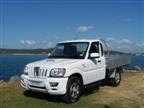
Mahindra Pik-Up
road test
..... more
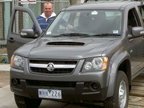
Holden Colorado LX 4x4
road test
..... more
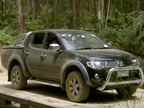
Mitsubishi Triton GLX-R
road test
..... more
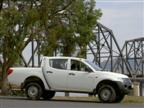
Mitsubishi Triton GLX 4x4
road test
..... more
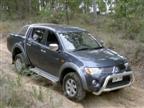
Mitsubishi Triton GLX-R
road test
..... more
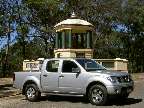
Nissan Navara ST-X
road test
..... more
|
|
|
The MZ-CD 2.2 delivers maximum power of 110 kW at 3,700 rpm and maximum torque of 375 Nm at
1,500–2,500 rpm. It features latest-generation common-rail injection technologies including the 1,800
bar ultra-high-pressure fuel system, which is tuned to suit the four-cylinder engine characteristics.
It also features an oil-cooled Variable Nozzle Turbocharger (VNT) similar to that in the MZ-CD 3.2 I5.
The intercooler of the MZ-CD 2.2 has greater dimensions than that of the outgoing MZ-CD 2.5 (670 mm
width, 196.7 mm height, and 38 mm depth versus the current 200 mm width, 145.3 mm height, and 64 mm
depth).
MZ-CD 3.2 I5
The new 3.2-litre diesel engine has an in-line 5-cylinder configuration (a first for Mazda) with
20 valves, a turbocharger with an intercooler, and the latest common-rail direct injection
technologies. It has a bore of 89.9 mm and a stroke of 100.7 mm for a displacement of 3,196 cc. It
gives maximum power of 147 kW at 3,000 rpm and maximum torque of 470 Nm at 1,750–2,500 rpm (EEC).
The MZ-CD 3.2 I5 has a cast-iron cylinder block, which is divided into upper and lower parts. The
upper and lower parts have a ladder-frame construction for superior stiffness in the block, main
bearings, and transmission mount and accordingly low noise and vibration. A lightweight aluminium
cylinder head has a two-part design that enables the top half of the cylinder head to hold the
camshafts. The camshaft system is driven by a maintenance-free timing chain. Maintenance-free
hydraulic lash adjusters are integrated into the rocker arms. They make valve-clearance adjustment
unnecessary and help to limit noise and vibration.
The MZ-CD 3.2 I5 is Mazda’s first 5-cylinder engine. A greater displacement than that of the MZR-CD
3.0 was desired for higher power and torque, but the 4-cylinder configuration of the MZR-CD 3.0 was not
appropriate; enlarging the bore or stroke of a 5-cylinder engine tends to cause NVH issues that result
in the need for a balancer shaft or other measures to reduce second-order shaking forces; the engine
becomes excessively big. By choosing the I5 configuration, a highly efficient, compact engine design
was realised; the MZ-CD 3.2 I5’s external dimensions are only slightly greater than those of the
four-cylinder MZR-CD 3.0.
The engine is longitudinally positioned closer to the vehicle's centre of gravity to minimise the
inertial moment. The greater number of cylinders means shorter (but consistent) combustion intervals
and accordingly limited vibration and noise.
The MZ-CD 3.2 I5 has a common-rail direct-injection system. A three-piston high-output fuel pump
supplies fuel at an ultra-high pressure of 1,800 bar (200 bar higher than the system of the MZR-CD 3.0)
through a precise multi-stage injection system with piezo injectors. An optimal cone spray angle for
each injector and precisely controlled injection timing complement the high injection pressure to
realise optimal combustion throughout the combustion chambers so the system achieves better fuel
economy without detracting from power. The result is a combination of high power, low fuel consumption,
low emissions, and quiet operation.
The engine has an oil-cooled variable-nozzle turbocharger (VNT) in which electronically adjusted
guidevane geometry optimises the speed and volume of the exhaust gases that strike the turbine blades,
thereby suppressing turbo lag and enabling 'torquey' performance throughout the rev range. The
intercooler has greater cooling capacity than that of the MZR-CD 3.0 owing to bigger dimensions (670
mm height, 213.9 mm width, and 38 mm depth versus the current 250 mm height, 206 mm width, and 65 mm
depth).
The intake system is made of plastic, which has the merits of lightness and formability into complex
shapes. It’s optimally tuned to ensure that the same amounts of air and recirculated exhaust gases go
into each cylinder for low emissions.
A shut-off shake reduction system in the intake system significantly reduces the shake usually
associated with diesel engines when they’re shut down; it electronically closes the throttle at the
moment the driver turns off the ignition switch, thereby softening the rate at which the engine shuts
down.
The exhaust gas recirculation (EGR) system has a high-efficiency EGR cooler that further lowers the
temperature of combustion and thereby suppresses nitrogen-oxide (NOx) emissions. The system is compact
and has highly efficient internal components.
A powerful DC-motor-actuated valve on the cold side of the cooler controls EGR operation for
optimal performance.
To promote fuel efficiency, the vacuum pump is camshaft-driven. It’s less prone to oil leaks than
conventional front-end-accessory-driven devices, and its lower rotation speed contributes to higher
engine durability. The camshaft-driven vacuum pump also eliminates the need for an external oil feed
for lubrication. Also, a variable-flow oil pump has feedback control, which enables it to supply the
required amount of oil only when the engine needs it. Relatively low power requirements for the oil
pump mean low mechanical losses and accordingly good fuel efficiency.
A deep-draw oil sump allows an oil pick-up location in the centre for reliable off-road performance.
An oil drain plug on the right-hand side enables easy user access. Oil vapour that builds up inside the
engine is separated out and returned to the sump by a crankcase ventilation system that has an oil
separation function.
Engine noise and vibration are suppressed by a steel front cover, by mass dampers on high-pressure
fuel pipes, by tuned ribs in the sump, and by insulation around the injectors. Even the fuel-injection
timing is tuned to minimise noise.
For the durability needed for reliable performance, the materials and coatings in the fuel supply
system are strong enough to withstand fuel additives used in any part of the world. Also, the
alternator is mounted high for good water-wading performance.
Transmissions
The all-new Mazda BT-50 is offered with a six-speed manual transmission or six-speed electronically
controlled automatic transmission (model dependant).
Both these transmissions are new and fully exploit the performance of the newly developed diesel
engines, promote fuel efficiency, and give a sporty type shift feel.
6-Speed Manual Transmission
The new 6-speed manual transmission has a short shift lever that’s optimally positioned for the
driver, so it offers crisp, precise shifting that’s well matched to the torque of the new diesel
engines. It’s paired with both the MZ-CD 3.2 I5 and MZ-CD 2.2. engines. Rigid laser-welded
synchronisers accommodate the engine torque while ensuring smooth shift operation with a light lever
action. The first and second gears have triple-cone synchronisers. The third and fourth gears have
double-cone synchronisers. The fifth and sixth gears have monocone synchronisers (not laser welded
but spline-fitted). And the reverse gear has a laser-welded monocone synchroniser. Each synchroniser
is specified to optimise the transmission’s shifting characteristics.
The transmission has a link-type shifter with a decoupling device between the main and selector
rails. This configuration enables a shorter shift lever and shift stroke than those of the current
manual transmission. An upshift indicator in the tachometer promotes fuel economy by helping the
driver avoid using unnecessarily high engine speeds. A reverse inhibition function prevents the
shift lever from being moved to the reverse position unless a collar on the shift knob is pulled up.
Strong internal components such as hard-machined gears ensure durability.
6-Speed Automatic Transmission
The new 6-speed automatic transmission replaces the current five-speed automatic transmission
and is available on certain models specified with the MZ-CD 3.2 I5 engine.
Closely spaced gear ratios with a wide spread give torque from low engine speeds while helping to
realise low emissions and improved fuel efficiency. The transmission has its own control unit, which
allows high-speed gearshift control while communicating with the engine control module to enable
smooth and precise shifting.
It also features advanced shift-control technologies that have been adopted in Mazda passenger
cars such as the Mazda 6. These technologies include Active Adaptive Shift (AAS), which optimises
gearshift control in accordance with the driver's intentions, which it infers from multiple data
and from driving conditions.
The AAS uses variables such as acceleration and deceleration rates, brake and throttle use, and
cornering speeds to ensure that the vehicle is always in the right gear at the right time without
undesired gearshifts. It greatly improves the vehicle’s driveability and performance feel, thereby
supporting the driver in a linear, dynamic manner. On downhill roads, the AAS automatically
downshifts to generate additional braking from the powertrain when it senses that the driver is
applying the brakes. It thereby promotes downhill safety.
The 6-speed automatic transmission also has Sequential Shift Control (SSC), which offers Normal
and Performance modes plus a Manual mode that allows sequential manual shifting. The Performance
mode gives more responsive acceleration. In the Manual mode, the driver can select gears as with a
manual transmission.
The torque converter has hydraulic slip lock-up control, which is optimised for refinement and
fuel efficiency. Extensive use of full and partial torque converter lock-up also contributes to
fuel economy while promoting shift response.
|
|
|

Self-Catering Holiday
Accommodation in
Denmark, WA
..... more
|
|
|
Gear ratios
1st 4.171
2nd 2.342
3rd 1.521
4th 1.143
5th 0.867
6th 0.691
Reverse 3.403
Final drive ratio 3.730
Fuel Economy
The new powertrain technologies not only give power and torque; they also give fuel efficiency,
which translates into economical running with a small environmental impact.
Also, the capacity of the fuel tank (made of tough, lightweight plastic) has been increased to
80 litres with all body types regardless of drive system.
Four-Wheel Drive (4WD) system
All three body types of the new Mazda BT-50 are available with a 4WD system for greater rough-road
mobility. Every 4WD Mazda BT-50 (regardless of whether its transmission is automatic or manual) has
an electronically controlled, shift-on-the-fly transfer case that allows the driver to shift between
2WD and 4WD at any time using a switch conveniently located on the floor console. Low-range gearing is
available for extra torque or downhill braking.
The driver can choose from three driving modes: 2H (2WD high range) for all normal-road driving and
for off-road driving on dry, level terrain; 4H (4WD high range) for off-road driving; and 4L (4WD low
range) for more extreme off-road conditions such as steep ascents and descents, for low-speed
manoeuvring, and for standing starts when the vehicle is heavily loaded or towing.
The driver can shift between 2H and 4H with the vehicle moving at speeds up to 110 km/h and the
accelerator pedal released. For shifting between 4H and 4L, the driver must stop the vehicle and
press the clutch pedal (with a manual transmission) or place the shift lever in the neutral position
(with an automatic transmission).
Electric locking rear differential
An electric locking rear differential is standard on all 4x4 versions. It maximises off-road grip by
locking both rear wheels so they both receive the same amount of torque, even when one has lost traction.
The locking rear differential thereby promotes off-road running stability and helps the driver extricate
the vehicle when it’s stuck in soft ground. The driver activates and deactivates the locking rear
differential using an easy-to-reach switch on the centre console.
For rough-terrain driveability, the new BT-50 has high ground clearance and ample approach, departure,
and break-over angles. Unladen and shod with 265 tyres, the Dual Cab XTR has ground clearance of 237 mm,
an approach angle of 28.2°, a departure angle of 26.4°, and a break-over angle of 25.0°.
The new BT-50 has water-wading performance thanks partly to the high-mount alternator. The maximum
wading depth is 600 mm for 2WD vehicles (up from the current 450 mm) and 800 mm for 4WD vehicles (up
from the current 750 mm).
Steering, Handling, and Ride
The first target was the kind of steering and handling that are unique to Mazda, so the suspension,
steering, and frame were all refined with a focus on achieving a linear steering feel. As a result, the
new BT-50 gives a precise steering feel that’s characterised by smooth, linear response to even the
smallest steering inputs during straight-line driving.
With regard to ride comfort, the new BT-50 gives a smoother ride than previous Mazda utes.
Suspension
The all-new BT-50 has newly developed double-wishbone suspension at the front. Coil springs give
more linear response than the current BT-50’s torsion-bar spring. The stabiliser control link is
attached to the axle rather than to the lower arms (as it is on the outgoing BT-50); a higher lever
ratio makes the stabiliser more effective for better roll stiffness. Newly optimised front-suspension
geometry suppresses disturbances from the road surface. And the lower-arm bushings are made of
high-damping rubber, which limits steering shimmy and promotes ride comfort.
The rear suspension has the same configuration as that of the former BT-50 (rigid axle with leaf
springs) but incorporates enhancements for superior steering and handling and ride comfort.
For better steering response, leaf-spring hard points such as the shackle mountings and leaf-eye
bushings were optimised to achieve optimal roll behaviour with respect to steering inputs. The
rigidity of the shackle modules were increased for optimal compliance steering; whereas the shackles
are attached to brackets on the bottom of the frame on the current BT-50, a support structure was
adopted in which the upper pins pass through the frame. With the new configuration, the frame’s
torsional rigidity can be used effectively as support stiffness for the shackles. The thickness of
the shackle plates has also been increased for greater rigidity in the entire shackle units.
The leaf springs on the new BT-50 are 1,330 mm long (10 mm longer than those on the former BT-50).
The extra length promotes ride comfort. Also, the leaf-eye bushings at the front have a diameter of
55 mm (15 mm bigger than those on the outgoing model).
Steering
Whereas the current BT-50 has ball-and-nut steering, the new BT-50 has rack-and pinion steering
(the type of steering widely used on passenger cars). The rack-and pinion mechanism is rigid, works
more precisely, and gives better road feel. Its advantages were heightened even further by using a
rigid mounting structure without rubber bushings for the gearbox. The rigid mounting structure makes
the steering feel even more direct.
Also, the steering-gear ratio is quicker than that of the current BT-50 (changed from 19.6 to
16.3 for 2WD vehicles and from 21.0 to 16.7 for 4WD vehicles and 2WD Hi-Rider vehicles), so it makes
the steering feel lighter and the vehicle easier to manoeuvre.
Although the new Mazda BT-50 has longer wheelbases than its predecessor (235 mm longer with 2WD
vehicles and 220mm longer with 4WD vehicles), increased maximum steering angles yield smaller
turning circles (11.8m with 2WD vehicles and 12.4 m with 4WD vehicles and 2WD Hi-Rider vehicles).
Newly fitted damper valves on the steering gearbox suppress disturbances from the road, thereby
enabling a smooth steering feel. Newly optimised power-assistance characteristics contribute to a
more linear steering feel.
Frame
The sturdy ladder frame-type of the former BT-50 has been adopted with a number of rigidity
improvements for greater nimbleness and ride comfort. The closed-section side rails were made
taller, wider, and straighter.
Consequently, the frame has improved levels of rigidity (about 2.6 times the flexural rigidity
and about 2.1 times the torsional rigidity of the outgoing BT-50’s frame).
Cab mounts
The cab mounts that join the cabin to the frame suppress the transmission of vertical,
longitudinal, and lateral oscillation to the cabin. The front mounts are solid rubber like those
of the outgoing BT-50. The left- and right-hand mounts under the pillars at the back of the cabin
are newly liquid-filled. Resonance caused by the repetitive movement of the liquid damps
low-frequency vibration, thereby suppressing shake for a more comfortable ride.
There’s no resonance at other frequencies, so it was possible to lower the dynamic spring
constant at 100Hz and higher (the frequency range relevant to booming noise and other kinds of
noise).
Since the damping force and dynamic spring constant were able to be tuned separately, the ride
comfort and NVH suppression were able to be simultaneously improved.
Braking
Like the outgoing BT-50, the new BT-50 has ventilated disc brakes at the front and drum brakes
at the rear. Improvements in brake response and linearity realise braking performance that
inspires the confidence essential for an enjoyable driving experience.
The diameter of the front brake discs has been increased from 14 inches to 16 inches on all
vehicles for greater heat capacity. And the single-piston callipers on 2WD vehicles have been
replaced with the twin-piston callipers that feature on all 4WD models. The result is significantly
better brake performance.
A highly responsive pedal feel has been achieved by means of boost characteristics that
optimally match the pedal ratio.
NVH Reduction
Comprehensive steps were taken to suppress NVH in order to achieve the kind of quiet, comfortable
driving experience that’s experienced in passenger cars. To limit vibration and noise while the engine
is idling, increased rigidity in the frame was supplemented with increased rigidity in the framework
of the cabin and softened the engine mounts and transmission mounts.
Since vibration inputs to the cabin are accordingly reduced, noise in the cabin by the driver’s
window is down from 55.1dBA in the current BT-50 to 49.6dBA in the new BT-50. The average level in
competing models is a noisier 52.0dBA. Vibration in the seat mounts and vibration in the steering
wheel are both about half of what they are in the outgoing BT-50.
To reduce booming noise and road noise, the rigidity of the brackets and members that join the
cabin to the frame was increased. The higher rigidity works with the softer engine and transmission
mounts to limit transmission of noise and vibration to the cabin while the vehicle is moving. Also, an
increased diameter and softer materials for the leaf-eye bushings in the rear suspension limit
transmission of resonance in the powertrain to the cabin via the rear suspension (a problem to which
vehicles with leaf springs are prone). Booming noise is as low as (or lower than) that in the outgoing
BT-50 at any engine speed. Damping material on the floor and other parts of the body shell cuts noise
even further.
To keep sound that radiates from the engine and tyres out of the cabin, seals on the body, doors,
and mudguards were improved. Notably, double door seals were adopted. To sound-insulate the engine, an
engine-top cover was adopted on XTR and GT models.
And to keep wind noise and the tyre noise out of the cabin, the pillars have been filled with
sound-insulating foam (a technique widely used with passenger cars).
Aerodynamics
A vehicle’s aerodynamic performance influences its high-speed driving stability and fuel economy and
its interior noise.
To manage the vehicle’s underfloor airflow for low drag and, accordingly, high fuel efficiency, a
chin spoiler has been adopted. The chin spoiler lowers drag by 3.5%. It also cuts front lift by 50%, so
it improves the vehicle’s overall lift balance and its driving stability.
The airflow behind the cabin also affects drag. Through collaboration with the design studio and
manufacturing teams, the shape of the rear pillars and the geometry of the rear combination lamps with
each body type was optimised.
Drag and wind noise was reduced further by integrating the mirror sails into the A-pillars. Early in
the vehicle programme, a computational-fluid-dynamics model was developed and it was used to study
combinations of A-pillars and mirror sails. The results facilitated great design freedom and
engineering efficiency.
Body styles and features
Mazda adopted brand-new architecture from the platform up. All body types in terms of overall length,
overall width, and overall height have been increased and enabled packaging that permits more space in
the cabin and more cargo-carrying capacity in the cargo box.
In Dual Cab models front occupants benefit from 16 mm more head room and 30 mm more shoulder room.
Rear-seat passengers also feel the difference with 55 mm more leg room while a wider cabin means more
space between passengers.
With the overall length and width of the new model increasing by 204 mm and 43 mm respectively
over the outgoing equivalent 4x4 model, cargo space is the other winner.
The cargo tray now measures 1,549 mm by 1,560 mm and the amount that can be packed into the new
BT-50 is even greater than ever before.
The all-new design incorporates higher sides to the cargo tray which increase the maximum cargo
volume to 1,214 litres, an increase of 178 litres over the former dual cab model.
To deliver improved interior comfort and convenience newly designed seats, new equipment, and
handy storage spaces for small items have been adopted.
Body Types
The all-new Mazda BT-50 is available in a choice of three body styles:
Single Cab (in cab-chassis)
Freestyle Cab (in both utility and cab-chassis)
Dual Cab (in both utility and cab-chassis)
Freestyle Door System
The Freestyle Cab features Mazda’s unique Freestyle Door System, first introduced on the RX-8.
On each side of the cabin, a front-hinged front door and a rear-hinged rear access panel realise a
1,408 mm-wide opening that allows people to get in and out of the front and rear seats with ease.
The rear access panels open to an angle of about 90°, so it’s not only easy for passengers to get
in and out of the rear seat but also easy to lift cargo in and out of the rear seating area.
For safety, the handle for opening and closing each rear access panel can’t be operated unless
the front door on that side of the body is open.
Seats
XTR models feature a driver’s seat with an adjustable lumbar support that reduces driver fatigue.
On Single Cab models the current three person bench seat has been replaced with a newly designed
arrangement. Driver comfort has been improved by dividing the width 40:60 between the driver and
passengers.
The Dual Cab has a three-person rear seat with a comfort-oriented design like that of the front
seats. The seatback height has been increased by 65.6mm and the seat-cushion length optimised.
Rear-seat headrests have been changed from the current built-in type to a new height adjustable
type.
Audio System
Every vehicle in the new Mazda BT-50 line-up has an AM/FM radio, an MP3-capable CD player, and an
AUX socket as standard equipment. All models have a modular system, which works with a multi-function
display situated in an easy-to-see position near the top of the centre stack. The display is a
3.5-inch monochrome super-twisted nematic (STN) display for XT models and a 5-inch colour liquid
crystal display (LCD) with Satellite Navigation for XTR and GT models.
All models feature functions typically seen in passenger cars (for example, USB connectivity for
portable audio players, Bluetooth® connectivity for mobile telephones, and voice control). All Dual
Cab models feature 6 speakers.
Trip Computer
The standard trip computer is between the speedometer and tachometer in the meter cluster. It gives
the driver easy-to-read digital indications of the following information:
• average fuel consumption
• instantaneous fuel consumption
• distance to empty
• average speed
• outside temperature (optional)
Climate-Control System
A manual air conditioning system features on XT models and a new dual-zone climate control air
conditioning has been added to XTR and GT models
The control panel is in an easy-to-reach position in the centre console. It has three dial-type
controls: left-hand temperature, blower speed, and right-hand temperature.
With the climate control air conditioning, each temperature setting is shown by an easy-to-read
digital display on the dial. The in-dial displays allow easy operation since the user doesn’t need
to look at a display in a separate place while turning the dials.
Air-conditioning performance with both systems is significantly improved compared with the
outgoing model. The condenser capacity has been increased by 80% and the compressor capacity
reduced from 150 cc to 130 cc, thereby improving air-conditioning performance and fuel economy.
Maximum airflow has also been increased from 96 litres per second to 135 litres per second.
Measurements taken in a range of conditions show that the new BT-50’s systems can cool the cabin to
temperatures 3–5°C lower than the current BT-50’s system can.
Cargo Box
The cargo box has been made significantly bigger in line with the increased overall length and
overall width of the body. The box panels have also been made taller, thereby achieving improved
cargo capacity with every body type.
With every cabin type, the floor width of the cargo box has been increased by 104 mm and the
height of the cargo box by 48 mm. The floor length of the cargo box by has been increased by 19–94
mm depending on cabin type. As a result, the maximum cargo volume has been increased by 178 litres
to 1,214 litres with the Dual Cab and by 226 litres to 1,453 litres with the Freestyle Cab.
Towing Capacity
Models powered by the MZ-CD 3.2 engine can tow up to a maximum of 3,350 kg and those powered by
the 2.2 litre engine have a maximum towing capacity of 2,500 kg. Both have 10% maximum allowable
down ball weight of 335 kg and 250 kg respectively.
Manufacturer’s List Price* (MLP*)
XT 4x2 Freestyle Cab Chassis 6MT $32,590*
XT 4x2 Dual Cab Utility 6MT $36,090*
XT 4x2 Dual Cab Utility 6AT $38,090*
XTR 4x2 Dual Cab Utility 6MT $40,740*
XTR 4x2 Dual Cab Utility 6AT $42,740*
XT 4x4 Freestyle Cab Chassis 6MT $40,660*
XTR 4x4 Freestyle Cab Utility 6MT $46,810*
XT 4x4 Dual Cab Chassis 6MT $42,660*
XT 4x4 Dual Cab Utility 6MT $44,160*
XT 4x4 Dual Cab Utility 6AT $46,160*
XTR 4x4 Dual Cab Utility 6MT $48,810*
XTR 4x4 Dual Cab Utility 6AT $50,810*
GT 4x4 Dual Cab Utility 6MT $50,710*
GT 4x4 Dual Cab Utility 6AT $52,710*
Cab Chassis models do not include a cargo tray.
Pricing of Single Cab models will be released closer to on-sale date.
Pricing of Boss Adventure and Boss Sports kits will be announced soon.
NOTE: * Manufacturer's List Price (MLP) excludes dealer delivery fees and the numerous statutory
charges (commonly known as on-road costs). Additionally, please note that all prices, fees and charges are
subject to change without notice, as are the specifications.
|